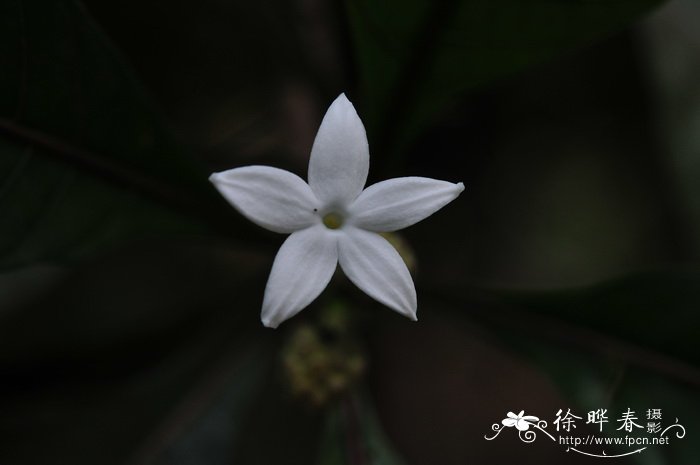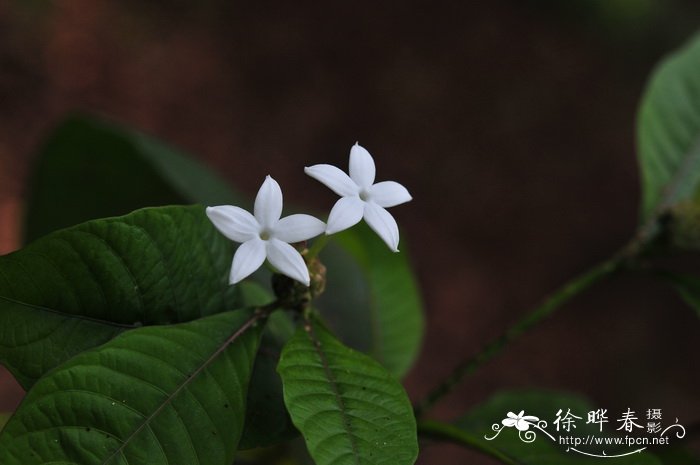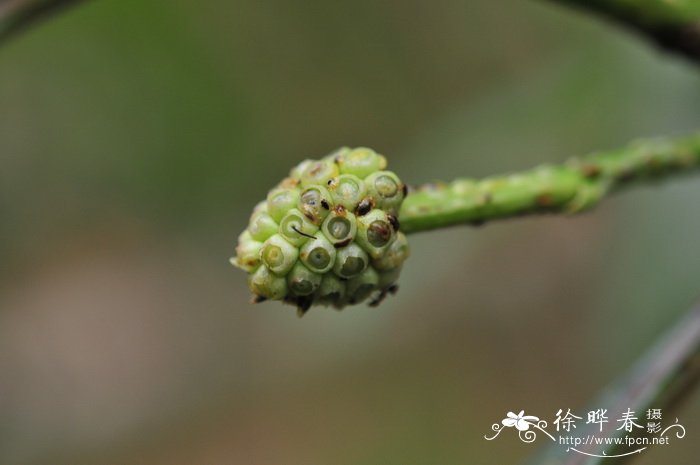黄木巴戟Morinda angustifolia
中文名(Chinese Name):黄木巴戟
学名(Scientific Name):Morinda angustifolia Roxb.
英文名(English Common Name):
别名(Chinese Common Name):狭叶巴戟
异名(Synonym):Morinda squarrosa Buch.-Ham. Morinda angustifolia var. scabridula Craib
科属(Family & Genus):茜草科(Rubiaceae)巴戟天属
形态特征(Description):直立灌木或小乔木,高约6米;枝四棱形,无毛。叶对生或单叶与花序对生,干后棕绿色,长圆形、椭圆形、长圆状披针形或倒披针形,长15-30厘米,宽6-10厘米,顶端渐尖,基部渐狭成短柄,全缘,上面无毛,下面粗糙无毛或脉处有疏短粗柔毛;侧脉每边9-13条,网脉明显;叶柄长0.5-1厘米;托叶生叶柄间,每侧2片,分离,钻形,或合生,渐尖或急尖。头状花序与顶叶对生;花序梗长1.5-4厘米;花多数,无梗,具钻形小苞片;花萼管部花时各花彼此紧贴,后变为下部多少合生,檐部环状,截平;花冠纯白,高脚碟形,向内弯,管部长约1.6厘米,内面和喉部无毛,檐部5裂,裂片卵状披针形,长约4毫米;雄蕊5,着生冠管下部,花丝短,花药长约5毫米,线形,内藏;花柱外伸或内藏,顶端2裂,子房4室,每室具胚珠1颗;胚珠着生子房隔下部,横生。聚花核果浆果状,熟时白色或黑色,桑椹果形,径可达2.5厘米;核果基部多少彼此合生或近分离,倒卵形,具种子4颗。花果期夏秋季。
分布(Distribution):产云南,生于海拔500-1400米的林中。印度、尼泊尔、不丹、缅甸和老挝有栽培或野生。
用途(Use):本种木材黄色,其木材、树皮和根可提炼染料,是民间常用的染料植物之一。
引自中国植物志英文版:FOC Vol. 19 Page 221, 222
Morinda angustifolia Roxburgh, Pl. Coromandel. 3: 32. 1815.
黄木巴戟 huang mu ba ji| Rubiaceae | Morinda
Erect shrubs or small trees, ca. 6 m tall; branches quadrangular, glabrous. Leaves opposite, or solitary opposite an inflorescence; petiole 0.5-1 cm, glabrous; blade drying papery, matte on both surfaces, brownish green, elliptic-oblong, elliptic, oblong-lanceolate, or oblanceolate, 15-30 × 6-10 cm, adaxially glabrous, abaxially scabrous to glabrous or sometimes sparsely hirtellous on veins, base acute to attenuate, apex acute to acuminate; secondary veins 9-13 pairs; stipules interpetiolar, free or shortly united to petioles, triangular, 4.5-5 mm, acuminate or acute. Inflorescence solitary and leaf-opposed; peduncle 1.5-4 cm; flowering head 1, subglobose to cylindrical, many flowered, 0.8-2.5 cm (not including corollas); bracteoles subulate. Flowers fused only shortly at base, distylous. Calyx glabrous; limb truncate to denticulate, ca. 1 mm. Corolla white, salverform, outside glabrous; tube cylindrical to slenderly funnelform, 16-33 mm; lobes 5, ovate-lanceolate, 4-15 mm, acute. Ovary 4-celled. Drupecetum mulberry-shaped, subglobose, or ellipsoid-oblong, to 2.5 cm in diam. Drupes partially fused to nearly separate, white or black, obovoid to subglobose, 10-15 mm. Fl. Apr-May, fr. summer-autumn.
Forests; 500-1400 m. S Yunnan [Bhutan, India, Laos, Myanmar, Nepal, Thailand].
The inflorescences are indeterminate and begin flowering with ± a dozen developed buds; the flowers continue to be produced through growth at the top of the spike while the fruit are developing on the lower parts, thus the older inflorescences become cylindrical or oblong in shape. Y. Z. Ruan (in FRPS 71(2): 185. 1999) described the inflorescence position as consistently leaf-opposed at the terminal node; however, inflorescences can also be found along the stem well below its apex (e.g., Tsi Zhanhou 92-130, MO), and the infructescences are usually found along the stem well below the apex (e.g., Puff et al., Rubiaceae of Thailand, 113. 2005).



(责任编辑:徐晔春)
学名(Scientific Name):Morinda angustifolia Roxb.
英文名(English Common Name):
别名(Chinese Common Name):狭叶巴戟
异名(Synonym):Morinda squarrosa Buch.-Ham. Morinda angustifolia var. scabridula Craib
科属(Family & Genus):茜草科(Rubiaceae)巴戟天属
形态特征(Description):直立灌木或小乔木,高约6米;枝四棱形,无毛。叶对生或单叶与花序对生,干后棕绿色,长圆形、椭圆形、长圆状披针形或倒披针形,长15-30厘米,宽6-10厘米,顶端渐尖,基部渐狭成短柄,全缘,上面无毛,下面粗糙无毛或脉处有疏短粗柔毛;侧脉每边9-13条,网脉明显;叶柄长0.5-1厘米;托叶生叶柄间,每侧2片,分离,钻形,或合生,渐尖或急尖。头状花序与顶叶对生;花序梗长1.5-4厘米;花多数,无梗,具钻形小苞片;花萼管部花时各花彼此紧贴,后变为下部多少合生,檐部环状,截平;花冠纯白,高脚碟形,向内弯,管部长约1.6厘米,内面和喉部无毛,檐部5裂,裂片卵状披针形,长约4毫米;雄蕊5,着生冠管下部,花丝短,花药长约5毫米,线形,内藏;花柱外伸或内藏,顶端2裂,子房4室,每室具胚珠1颗;胚珠着生子房隔下部,横生。聚花核果浆果状,熟时白色或黑色,桑椹果形,径可达2.5厘米;核果基部多少彼此合生或近分离,倒卵形,具种子4颗。花果期夏秋季。
分布(Distribution):产云南,生于海拔500-1400米的林中。印度、尼泊尔、不丹、缅甸和老挝有栽培或野生。
用途(Use):本种木材黄色,其木材、树皮和根可提炼染料,是民间常用的染料植物之一。
引自中国植物志英文版:FOC Vol. 19 Page 221, 222
Morinda angustifolia Roxburgh, Pl. Coromandel. 3: 32. 1815.
黄木巴戟 huang mu ba ji| Rubiaceae | Morinda
Erect shrubs or small trees, ca. 6 m tall; branches quadrangular, glabrous. Leaves opposite, or solitary opposite an inflorescence; petiole 0.5-1 cm, glabrous; blade drying papery, matte on both surfaces, brownish green, elliptic-oblong, elliptic, oblong-lanceolate, or oblanceolate, 15-30 × 6-10 cm, adaxially glabrous, abaxially scabrous to glabrous or sometimes sparsely hirtellous on veins, base acute to attenuate, apex acute to acuminate; secondary veins 9-13 pairs; stipules interpetiolar, free or shortly united to petioles, triangular, 4.5-5 mm, acuminate or acute. Inflorescence solitary and leaf-opposed; peduncle 1.5-4 cm; flowering head 1, subglobose to cylindrical, many flowered, 0.8-2.5 cm (not including corollas); bracteoles subulate. Flowers fused only shortly at base, distylous. Calyx glabrous; limb truncate to denticulate, ca. 1 mm. Corolla white, salverform, outside glabrous; tube cylindrical to slenderly funnelform, 16-33 mm; lobes 5, ovate-lanceolate, 4-15 mm, acute. Ovary 4-celled. Drupecetum mulberry-shaped, subglobose, or ellipsoid-oblong, to 2.5 cm in diam. Drupes partially fused to nearly separate, white or black, obovoid to subglobose, 10-15 mm. Fl. Apr-May, fr. summer-autumn.
Forests; 500-1400 m. S Yunnan [Bhutan, India, Laos, Myanmar, Nepal, Thailand].
The inflorescences are indeterminate and begin flowering with ± a dozen developed buds; the flowers continue to be produced through growth at the top of the spike while the fruit are developing on the lower parts, thus the older inflorescences become cylindrical or oblong in shape. Y. Z. Ruan (in FRPS 71(2): 185. 1999) described the inflorescence position as consistently leaf-opposed at the terminal node; however, inflorescences can also be found along the stem well below its apex (e.g., Tsi Zhanhou 92-130, MO), and the infructescences are usually found along the stem well below the apex (e.g., Puff et al., Rubiaceae of Thailand, 113. 2005).
(责任编辑:徐晔春)
踩一下[0]

顶一下[0]